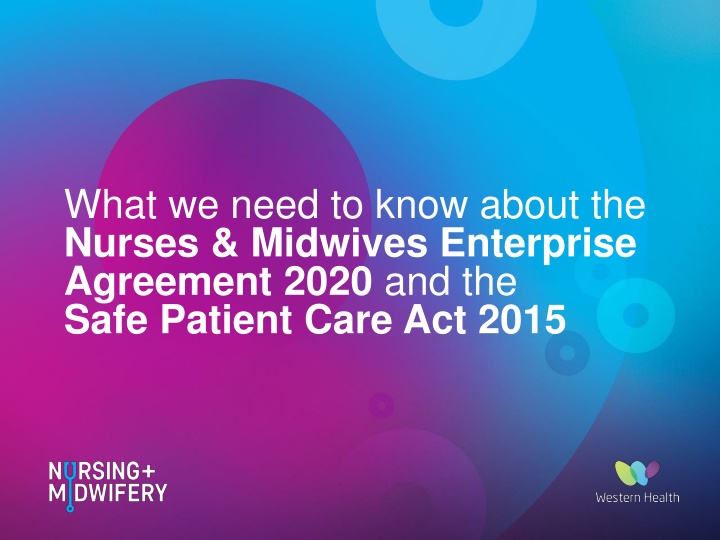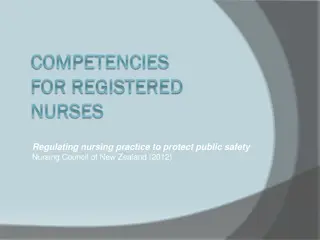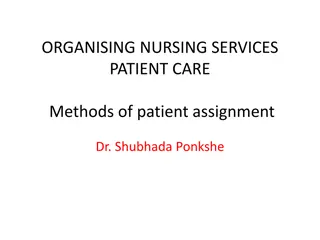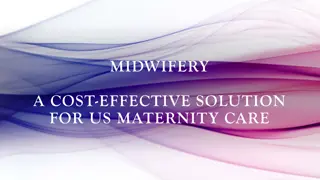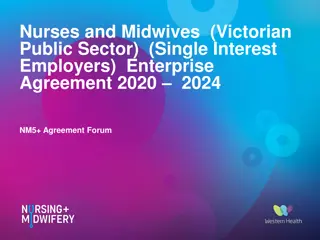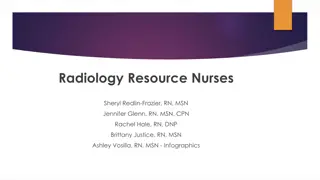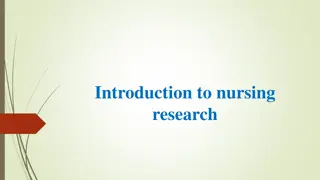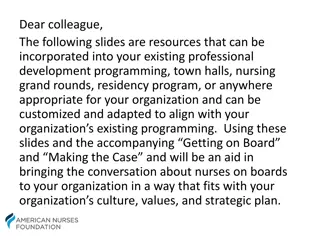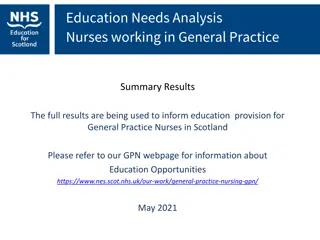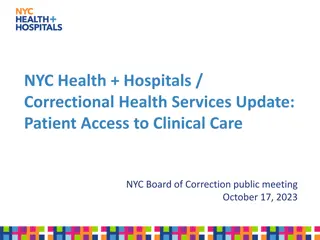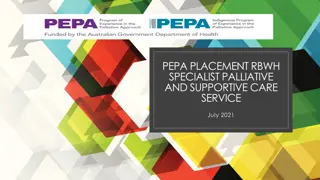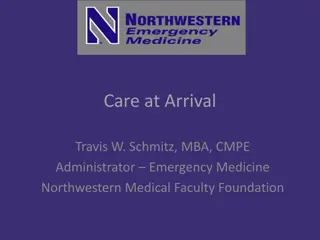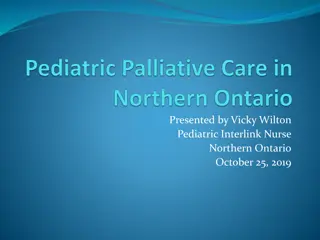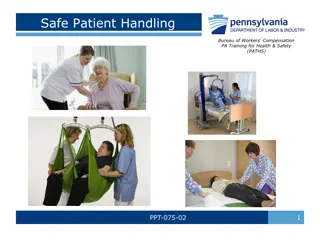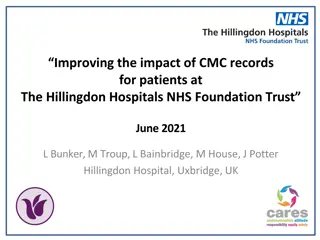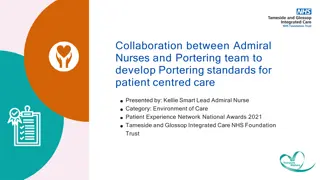Overview of Nurses & Midwives Agreement 2020 and Safe Patient Care Act
This overview covers the key aspects of the Nurses & Midwives Enterprise Agreement 2020 and the Safe Patient Care Act 2015, including definitions, coverage, and anti-discrimination policies. It also delves into specific clauses related to campus definitions, midwifery roles, and public mental health services.
Download Presentation

Please find below an Image/Link to download the presentation.
The content on the website is provided AS IS for your information and personal use only. It may not be sold, licensed, or shared on other websites without obtaining consent from the author.If you encounter any issues during the download, it is possible that the publisher has removed the file from their server.
You are allowed to download the files provided on this website for personal or commercial use, subject to the condition that they are used lawfully. All files are the property of their respective owners.
The content on the website is provided AS IS for your information and personal use only. It may not be sold, licensed, or shared on other websites without obtaining consent from the author.
E N D
Presentation Transcript
What we need to know about the Nurses & Midwives Enterprise Agreement 2020 and the Safe Patient Care Act 2015
Part A Preliminary This part covers: Definitions Coverage Date and Period of Operation Anti-discrimination Gender Based Discrimination
Definitions Clause 4.1(k) Campus CAMPUS Insertion of following definition Campus means a site operated by an Employer that provides day procedure surgery or multi-day inpatient services or residential aged care but excludes: a. a site that is a Community Health Centre; b. a site where the only service is Aged Care beds that do not meet the definition of High Care beds under the Safe Patient Care Act 2019; c. DHSV, d. Private residences. Provided that a satellite service co-located on a Campus controlled by another Employer is not a separate Campus for the purposes of this Agreement
Definitions Clause 4.1 Key Changes MIDWIFERY DEFINITIONS Inserted definitions to acknowledge Midwifery roles AMUM/MUM/DOM/RM EXPERIENCE/YEAR OF EXPERIENCE Inclusion of current guidance material for internationally trained employees EARLY PARENTING CENTRE amended to provide clarity and coverage where new EPCs are established during the life of this agreement
Clause 4.1 Definitions Enrolled / Registered nurse
Definitions Clause 4.1(kk) Public Mental Health Services a. 'Registered Nurse' means a person registered in Division 1 Registered Nurses of the Register of Nurses of the Nursing and Midwifery Board of Australia established by the Health Practitioner Regulation National Law Act 2009: but excludes a person employed solely or predominantly in the provision of Public Mental Health Services. In this Agreement, employed solely or predominantly in the provision of Public Mental Health Services , refers to the service, department, unit or program of the Employer rather than the duties of the individual employee. Example: a Registered or Enrolled Nurse who works in an ED Hub in an Emergency Department providing treatment for people that present with mental health, alcohol and other drugs issues is covered by this Agreement given the work of the relevant department as a whole.
Definitions Clause 4.1(kk) Public Mental Health Services (mm) Public Mental Health Services means mental health services delivered on a service, department, unit or program level operated by an employer covered by the Victorian Public Mental Health Services Enterprise Agreement 2016-2020 (or its successor).
Clause 10A Gender Based Discrimination An industry level standing committee of representative CEOs (or their nominees), DH, ANMF and VHIA to: review gender audit results, promote gender equity initiatives, and Identify and address any gender pay gaps in the public sector organisation.
Part B Consultation, Dispute Resolution and Discipline This part covers: Consultation Redundancy Dispute Resolution State-wide Classification Committee Managing Conduct and Performance Flexible Working Arrangements
Clause 11 Consultation Clauses has been amended to clarify the following: Consultation should include, where practical those employees who are absent on leave including on workers compensation leave. Additional statement at 11.3 to make clear that timeframes are indicative. Step 3 amended to clarify that prescribed meeting requirements do not limit the number of meetings the parties can agree to have. Highlight OHS issues. Require parties raise concerns over a Change Impact Statement as soon as practicable.
Clause 11 Consultation (Cont.) Clarification that where relevant to a proposed change, existing and amended position descriptions to be provided. Clause 11A - Consultation about changes to rosters or hours of work Clarification that 11A applies in circumstances where a change in roster or regular ordinary hours may impact an employee (such as their family and caring responsibilities) but is not the result of major change. Consultation required, but process less prescriptive than it is for major change . Some exclusions (sporadic unpredictable work hours, self rostering or, where permitted, rotating roster).
Clause 11B Consultation - Amalgamation of wards During life of the Agreement, there will be no amalgamations of wards that will result in: An increase in workload for Employees in those wards An increase in patient risk Without the agreement of ANMF and Employer. Consultation via clause 11 save that disputes are notified to Statewide Industry Panel. Panel will have Department of Health s ward Guidelines Key issue - the workload of nurse managers (NUMs and ANUMs).
Clause 12 Redundancy & Associated Entitlements RELOCATION ALLOWANCE Amended to clarify that the $1,900 relocation allowance is payable based on the written estimate where the Employer accepts that estimate represents the additional cost to the Affected Employee SPILL AND FILL - refers to a decision to reduce the number of employees required to do existing work. Employees who are being made redundant will be used to fill positions before considering other applicants. SUPPORTS TO AFFECTED EMPLOYEES career planning included as support that may be provided to redundant employees.
Clause 13 Dispute Resolution Procedure Key changes include: Definition of Party Discussions to be conducted in writing if mutually agreed Discussions to occur with relevant manager or line manager (to reflect existing practise) Obligation on either party to notify the other as soon as practical, in writing, where they believe the dispute resolution process at 13.4 is not being complied with. Specific reference to section 596 of the Fair Work Act concerning lawyers and paid agents.
Clause 14 Statewide Industry Panel Replaces the Statewide Classification Committee Altered Composition Greater focus on Industry participation Expanded Scope - The Panel will have responsibility for disputes regarding: Roles that do not fit within the existing classification structure, Classification disputes under the existing structure. Ward amalgamation disputes. However, access to FWC will be retained. Development and Finalisation of Classification descriptors Develop NUM Descriptors Advanced Practice/Liaison Nurse/Co-ordinators Clinical Nurse Consultants
Clause 15 Managing Conduct & Performance (Re-titled from Discipline ) STALE ALLEGATIONS Employers to raise issues as soon as practicable after becoming aware to avoid stale allegations. QUALIFYING PERIOD Employees in their qualifying (probationary) period will not need to go through stepped disciplinary process before termination. Procedural fairness still required (steps are set out). WHERE ISSUE UNDISPUTED ONE STEP The investigation step will not be required where there is no dispute over fact. The Employee will still be entitled to be heard before any penalty (if any) is determined, including on points of mitigation.
Clause 15 Managing Conduct & Performance (Cont.) (Re-titled from Discipline ) COUNSELLING RECORDS Amended to exclude employers from relying on counselling records after a period of 12 or 18 months has elapsed. PERFORMANCE IMPROVEMENT PLANS The relationship between performance management and discipline has been clarified. Disciplinary action and performance management can occur at the same time, however, performance management cannot be used to apply an additional sanction.
Clause 15 Managing Conduct & Performance (Cont.) (Re-titled from Discipline ) RESPONSE TO ALLEGATIONS Amended to ensure that the Employer provides the Employee with reasonable time to provide information in mitigation of any matters after being provided outcome of the investigation process, including the basis of any conclusion. OUTCOME Restructure of clause to distinguish between conduct that does not constitute serious and willful miscount and conduct that does. Clarification that a final warning given without following the steps in sub-clauses 15.5(a)(i) can only be given in the case of serious and willful misconduct.
Clause 16 - Flexible Working Arrangements Clause updated to fill in the gaps and reflect health sector standard Best practice guide has been developed and distributed Guide focused on Legislative requirements Also focusses on equity considerations
Clause 16A Individual Flexible Working Arrangements Inclusion of flexibility term in the agreement rather than the model flexibility term being an appendix. Reflects health sector standard.
Part C Types of Employment, Commencement of Employment & End of Employment This part covers: Employment Types Letter of Appointment Notice Periods Transition to Retirement
Clause 19 Casual Employment LONG SERVICE LEAVE Reference to long service leave (70.5(b)) removed from the list of entitlements that casuals do not have access to. Casuals are now specifically reference in clause 70, which details their entitlements under the Long Service Leave Act (Registered Nurses and Midwives) and the Agreement (Enrolled Nurses). CASUALS ARE NOT ENTITLED TO Absence on Defence Leave Special disaster leave CASUALS ARE ENTITLED TO Payment for mandatory training Unpaid ceremonial leave
Clause 21 Fixed Term Employment Changes to the clause include: Clarification that Fixed Term Employment cannot be used to fill an ongoing position Clarification that Fixed Term Employment can be used to backfill long- term leave (parental leave, long service leave) and support flexible working arrangements
Clause 22 Letter of Appointment Now requires employers to confirm any contract variations in writing
Clause 23 Notice Period Before Termination Certificate of service to be provided within 14 days where practicable upon termination. Also applies where an employee terminates employment but goes to casual bank.
Part D Payment of Wages, Employee Records and Related Matters This part covers: Salary Payment of Wages, Employee Records and Related Matters Superannuation
Clause 25 Wages Employee rates of pay will increase over the life of this Agreement as follows: from the FFPPOOA 1 December 2020 3%; from the FFPPOOA 1 December 2021 3%; from the FFPPOOA 1 December 2022 3%.
Clause 26 Payment of Wages, Employee Records & Related Matters EMPLOYEE RECORDS Payslip and record requirements updated to fully reflect requirements of Fair Work Act. INTRODUCTION OF BIOMETRIC TIMEKEEPING Where using biometric technology (new or existing) Employer to give consideration to an Employee with genuine difficulties in complying with a requirement to utilise biometric technology to mitigate or avert the impact on the Employee. TIMING OF PAYMENTS AFTER TERMINATION Where employee initiates termination, final payment no later than next ordinary pay day following end of employment.
Clause 27 Superannuation CHOICE OF FUND Amended to clarify that choice of fund applies to both employee and employer contributions . PARENTAL LEAVE 1 JULY 2021 Employees to receive superannuation based on previous ordinary time earnings (pre salary- packaging) during both paid and unpaid parental leave.
Part E Allowances & Reimbursements This part covers: Allowances Related Entitlements
Clause 30 Allowances Excepting Sunday night and relocation allowances, the rates for all allowances applicable to employees will increase as follows: from the FFPPOOA 1 December 2020 3% from the FFPPOOA 1 December 2021 3% from the FFPPOOA 1 December 2022 3% Excepting vehicle, uniform, laundry, telephone, change of shift and meal allowances, allowances will be calculated to the nearest 10 cents with any amount in the result not exceeding 5 cents to be disregarded. Change of shift allowances payable pursuant to clause 41 will be calculated to the nearest 5 cents, portions of a cent being disregarded.
Clause 30A Lead Apron Allowance Payable to employees required to wear a lead apron as part of their usual duties Amount of $8 per shift (Note this amount is not pro rated to reflect time spent wearing a lead apron) Payable from FFPPOOA 1 July 2020
Clause 31 TAE Qualification Allowance Inclusion of 3.5% of base rate allowance payable where: The Employer requires the Employee to hold the qualification It is the highest additional qualification held Effective FFPPOA 1 January 2021 Note this is a variation to the Qualification Allowance clause.
Clause 32 Rural and Isolated Practice Allowance RIPN allowance preserved and existing allowance available to new candidates. Removal of transition clause as no longer required.
Clause 33.4 Travel & Recall Amended to clarify that the allowance is payable where the employee is not at home when recalled.
Clause 34 Shift Allowance NEW Trial for increased Sunday night shift allowance The following will occur: Implementation of a data collection system and trial to test unplanned absences on weekends. Trial commencing 1 July 2023 to pay full time and part time employees who finish on a Monday after commencing duty on a Sunday a specific Sunday night duty allowance .
Clause 35 Enrolled Nurse Higher Duties NEW entitlements for ENs Applies where an Enrolled Nurse Employee is required to replace an ANUM In Charge of a high care residential aged care ward - paid the ANUM rate for that period. Conditions: Must have access to a Registered Nurse during the shift the Enrolled Nurse. EN can only be appointed to replace an ANUM in charge where a RN not available in a high care residential aged care ward.
Clause 36 Vehicle Allowance Removal of PMU terminology replaced with: Lower Rate - 4 cylinder and electric Higher Rate 5 cylinder and above Note inclusion of electric vehicles.
Clause 37 Travelling and Relocation The Agreement now provides coverage for the following circumstances: Where an Employee is required by the Employer to temporarily relocate from their Base Employment Campus to another Campus during a shift; Where an Employee is required by the Employer to temporarily relocate from their Base Employment Campus to another Campus prior to a shift; Where an Employee's position is required by the Employer to permanently relocate from their Base Employment Campus to another Campus and the Employee's position is not redundant. Entitlement - Concerns payment for the cost of travel and time spent travelling.
Part F Hours of Work and Related Matters This part covers: Hours of Work Breaks Rosters Overtime On-Call/ Recall Rest periods
Clause 42 Hours of Work 10 HOUR SHIFTS Rostering 10-hour shifts does not require mutual agreement (updating to reflect status quo)
Clause 42 Hours of Work (Cont.) 12 HOUR SHIFT CESSATION Process to end 12 hour shift arrangements clarified - either as per the 12 hour shift agreement or through clause 11 (Consultation) and, where relevant, clause 12 (Redundancy and associated entitlements) Minimum breaks for 12 hour shift arrangement as follows: 1 x 30 min unpaid meal break; and 1 x 20 min paid meal break; and 3x 10 min paid tea breaks
Clause 44 Breaks ESCALATION PROCESS Employers to explain in writing the steps to be taken if employee doesn t take a scheduled meal break (escalation process) with a view to: Wherever possible, rescheduling and taking meal break during shift, and Considering whether any additional action is required to address the causes of meal breaks not being taken and to reduce the likelihood of recurrence
Clause 44.3 Clothing Change Break Requirement to have local arrangements for employees who are required to change at the hospital (such as theatre staff) with this to occur during the shift.
Clause 45 Rosters Key Changes include: Posting of roster at least 28 days in advance. On-call roster Clear obligation to post written on-call roster At least 28 days in advance Limited to planned on-call May be separate to standard roster Change of roster allowance Amended from 1 July 2020 Without 14 days notice 2.5% of Base rate (as defined) Without seven days notice 5% of Base rate (as defined)
Clause 48 Special Rates for Saturdays & Sundays Explicit Rates for Casuals: all rostered time of ordinary duty performed between midnight on Friday and midnight on Sunday will be paid for at the rate of time and a half plus the casual loading (that is, 175%)
Clause 49 Overtime Explicit Rates for Casuals: Monday to Friday (inclusive) time and a half for the first two hours plus casual loading (175%), double time plus casual loading thereafter (225%); Saturday to Sunday (inclusive) double time plus casual loading (225%). Calculation - each day or shift stands alone: Where a period of overtime worked commences on one day and finishes on another, the calculation of overtime will be treated as if the overtime took place in a single day or shift.
Clause 49 Overtime (Cont.) REST BREAK DURING OVERTIME An Employee working overtime will receive a rest break of 20 minutes after each four hours of overtime worked if required to continue to work after the break. APPROVAL OF OVERTIME Clause outlines that a direction made by the nurse or midwife in charge for an Employee to work overtime is a direction or request of the Employer.
Clause 50 Recall Return to Workplace Clause has been amended as follows: time travelling to and from the place of duty when recalled will be deemed time worked. from 1 July 2021, Employees rostered on-call for the purposes of recall to staff an emergency in a Catheter Laboratory or Operating Theatre (including anesthetics or recovery) will not be used for non-emergency work overtime at the end of a shift. If this can t be avoided, treated as a recall.
